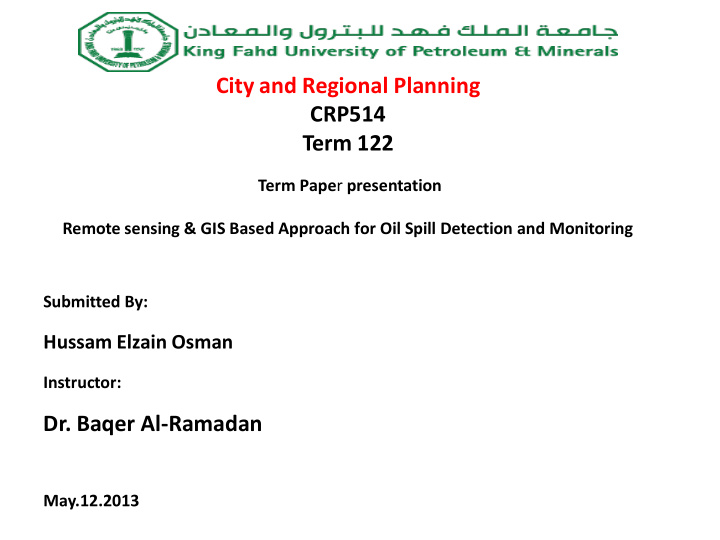



City and Regional Planning CRP514 Term 122 Term Pape r presentation Remote sensing & GIS Based Approach for Oil Spill Detection and Monitoring Submitted By: Hussam Elzain Osman Instructor: Dr. Baqer Al-Ramadan May.12.2013
Outlines Introduction Problem statement Objective Methodology Remote sensing technique GIS Approach Case study Result Conclusion
Introduction What’s oil spill ???
What are the causes ?
Objective Real – time oil spill detection and monitoring. Build up oil spill distribution map.
Methodology 1.Remote sensing technique. 2.Geographic Information system (GIS ).
Remote sensing multi- disciplines
Passive airborne sensors
Active Laser-Fluorescence Sensor
Satellite image , SAR SAR image concept
SAR images Area of the Baltic Sea with the German island of Fehmarn ,2007.
Area of the Baltic Sea with the German island of Fehmarn (in the center) (This ERS-2 SAR image was acquired on 10 May 1998 at 21:15 UTC over the Baltic Sea; orbit: 15972, frame: 1089, frame center: 54° 28'N, 11° 13'E, imaged area: 100 km x 100 km ).
GIS approach Information being received by GIS and its outputs (Ivanov and Zatyagalova, 2008)
NOAA's BP Oil Spill Incident Response Site (2010) internet mapping resource .
Gulf Response GeoPlatform through NOAA's ERMA (2010).
The Official Deepwater Horizon Response (2010) website now replaced by the Restore the Gulf website (2010
Literature review Andrei Yu. Ivanov( ) using GIS and SAR imagery for oil spill mapping in THE ASIAN SEAS , he conclude that the both GIS and SAR image useful for decision makers of pollution authorities andexperts of environmental protection agencies and also discus GIS to be an ideal solution to understand spatial/temporal distribution of oil spills in the marine environment. Lucy Aukett (2012) used modeling of geographic information system for mapping and delineate spill-affected Preparedness area in Australia . GIS provides a ideal tool for oil spill contingency planning and response facilitating and informing efficient specific responses underpinned by tailored analyses and interpretation of relevant data. Victoria V. Zatyagalova et al .(200 ) used SAR imagery ENVISAT for estimation and mapping of natural oil spell in the SOUTHERN CAPSIAN SEA .they reported that Advanced Synthetic Aperture Radar (ASAR) power tool for mapping and estimate oil seepage specially in SW Caspian Sea Where the spill rate is estimated about2 ,000- 16,000 metric tons of oil per year. Peng Liu et al (2007) , used SAR imagery based on fuzzy logic algorithm to identified ocean oil spills and their impact on marine life .they conclude Synthetic aperture radar (SAR) has been proven under low tomoderate wind conditions to be a useful tool for oil spill detection and Ocean oil spills cause serious damage to the marine environment, especially around coastal waters Oscar Garcia-Pineda et al .(2009) using SAR imagery with a texture-classifying neural network (TCNNA) algorithm to delineate ocean oil slicks in Gulf of Mexico. combinationvwith a large archive of SAR images over the Gulf of Mexico, TCNNA also will allow characterization of a multiyear processvlike flux variation of a natural hydrocarbon seepage source andvestimation of the entire Gulf of Mexico contribution ofvhydrocarbon transfer from the ocean to the atmosphere
Case study APPLICATION OF ENVISAT SAR IMAGERY FOR MAPPING AND ESTIMATION OF NATURAL OIL SEEPS IN THE SOUTH CASPIAN SEA Victoria V. Zatyagalova, Andrei Yu. Ivanov, (1)(2) Boris N. Golubov (3)
• Location • Oil production activity • Ecosystem marine • SAR image covered
Development oil field in caspian sea
Environmental imapct in caspian sea
Seven pair image SAR coverage caspian sea 2004-2006
Analysis of SAR Image Mosaic SAR Image ,CEP
Processing of SAR Image
Interpretation Of SAR Image .
Layers of GIS in Caspian sea Layer of GIS in Caspian sea ,after CEP .
GIS map shows integral distribution of oil seepage related to oil slicks based on seepage rate contour line.
GIS map shown oil slicks distribution SW Caspian Sea in relation to perspective (dark grey) oil and revealed (light brown) and and gas bearing structures
GIS distribution map of the slicks on the surface of the Caspian Sea related oil products, crude oil and other man-made pollution, oil slick accumulations shown by Ellipses areas over bottom seepages (violet), river run-off (red) and oil production fields (blue)
Result Analysis of reveals that the majority of the oil spills were detected in the southern part of the Caspian Sea. The sea was most polluted near the marine exploitation areas, oil rigs, close to seashore refinery plants, river mouths as well over the bottom oil seeps The main sources of oil pollution there are both point sources from rigs, terminals or seeps and distributed ones like slicks related to river runoff
Conclusion The environmental impact of the oil spill on marine biodiversity is expected to be Devastating. Integration of remote sensing and GIS technologies can significantly improve managing oil spills and allows making the final products – oil spill distribution maps the Caspian Sea and its coastal zones have a very high risk of oil pollution with a long-term effect on the sea and coastal marine resources
Recommend
More recommend